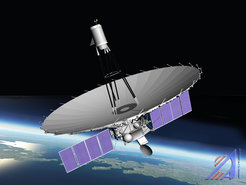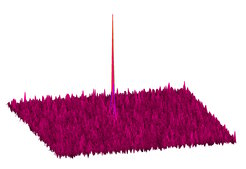The birth of a telescope 30 times larger than Earth
First interferometric signals detected between the Effelsberg 100-meter telescope and the space-borne antenna Spektr-R of the RadioAstron project


The technique of very long baseline interferometry, which has already set a number of world records in astronomy, now enters an entirely new era signaled by a successful detection of interferometric signals ("fringes") made in observations performed with the 10-meter space-borne antenna Spektr-R of the RadioAstron project, three 32-meter antennas of the Russian QUASAR Network, the Ukrainian 70-meter antenna in Evpatoria, and the German 100-meter radio telescope in Effelsberg. The detection was made on 15 November 2011, with observations performed at a wavelength of 18 centimeters and targeting bright and extremely compact radio emission from the distant quasar 0212+735.
"These fascinating results confirm our expectations that we will be able to probe with RadioAstron the conditions in the innermost regions of quasars with unprecedented detail", says Anton Zensus, director at the Max-Planck-Institut für Radioastronomie in Bonn and head of the institute's "Very Long Baseline Interferometry" (VLBI) research group. "The weak signals from such systems require the coordinated use of the most sensitive radio telescopes available such as the 100-m dish in Effelsberg."
In order to perform these observations, data from the space antenna of RadioAstron were recorded on-board and sent to the satellite tracking antenna in Puschino, Russia. These data have been subsequently combined with recordings made at ground-based radio telescopes participating in RadioAstron observations. This is done at a special RadioAstron correlator facility in Moscow. The RadioAstron correlator performs searches for correlations (or interferometric fringes) between the signals recorded at two or more antennas. Using these correlations, images of distant cosmic objects can be reconstructed at a resolution that would have been achieved with a telescope as large as the largest distance between the antennas participating in observations.
The satellite was about 100,000 km away from Earth during the observations of the quasar 0212+735. Planned observations with SpectR will extend out to 360,000 kilometers from the Earth, thus creating a telescope which is effectively 30 times larger than the size of our planet. This kind of telescope will achieve a resolution as fine as 1/100,000 of a second of arc. This resolution is sufficient for measuring the size of a one cent coin on the surface of Moon and reaches within a factor of two of the scale of the event horizon in the supermassive black hole in the center of our Galaxy.
"The RadioAstron team is very excited to get the first interferometric signals", says RadioAstron scientist Yuri Kovalev from Astro Space Center in Moscow. "This achievement confirms a successful operation of the extremely complex system and is a milestone that allows us to move forward to an extensive science program involving radio telescopes located throughout the world."
This exciting new capability promises to help tackling some of the most puzzling problems in astrophysics, including the origin of the most energetic particles in the Universe and the nature of supermassive black holes.

The RadioAstron project is led by the Astro Space Center of the P.N. Lebedev Physical Institute in Moscow, Russia.
The QUASAR Network is operated by the Institute of Applied Astronomy in St. Petersburg, Russia.
The satellite tracking antenna in Puschino (Russia) is part of the Puschino Radio Astronomy Observatory.
The 100-meter radio telescope in Effelsberg is operated by the Max-Planck-Institut für Radioastronomie in Bonn, Germany.
The 70-meter antenna in Evpatoria (Ukraine) is operated by the Ukrainian National Space Agency.
The orbiting Spektr-R antenna was constructed at the Lavochkin Association in Russia and launched on 18 July 2011 from the Russian space launch center in Baikonur (Kazakhstan) by the Zenit Russian-Ukranian rocket with the Fregat-SB booster. At present, the initial in-orbit checkout period of Spektr-R is nearing its completion and science observations are expected to begin in early 2012.


